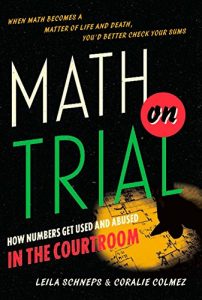In the wrong hands, math can be deadly. Even the simplest numbers can become powerful forces when manipulated by journalists, politicians or other public figures, but in the case of the law your liberty—and your life—can depend on the right calculation.
Math on Trial tells the story of ten trials in which mathematical arguments were used—and disastrously misused—as evidence. Despite years of math classes, most people (and most jurors) fail to detect even simple mathematical sophistry, resulting in such horrors as a medical expert’s faulty calculation of probabilities providing the key evidence for a British mother’s conviction for the murder of her two babies. The conviction was later overturned, but three years in prison took its toll—Sally Clark died of acute alcohol intoxication in March of 2007. Mathematicians Leila Schneps and Coralie Colmez use a wide range of examples, from a mid-19th-century dispute over wills that became a signal case in the forensic use of mathematics, to the conviction and subsequent exoneration of Amanda Knox, to show how the improper application of mathematical concepts can mean the difference between walking free and life in prison.
The cases discussed include:
-The Case of Amanda Knox (How a judge’s denial of a second DNA test may have destroyed a chance to reveal the truth about Meredith Kercher’s murder)
-The Case of Joe Sneed (How a fabricated probability framed a son for his parents’ grisly killing)
-The Case of Sally Clark (How multiplying non-independent probabilities landed an innocent mother in jail for the murder of her children)
-The Case of Janet Collins (How unjustified estimates combined with a miscalculated probability convicted an innocent couple of violent robbery)
A colorful narrative of mathematical abuse featuring such characters as Charles Ponzi, Alfred Dreyfus, Hetty Green, and Oliver Wendell Holmes, Math on Trial shows that legal expertise isn’t everything when it comes to proving a man innocent.
Math on Trial tells the story of ten trials in which mathematical arguments were used—and disastrously misused—as evidence. Despite years of math classes, most people (and most jurors) fail to detect even simple mathematical sophistry, resulting in such horrors as a medical expert’s faulty calculation of probabilities providing the key evidence for a British mother’s conviction for the murder of her two babies. The conviction was later overturned, but three years in prison took its toll—Sally Clark died of acute alcohol intoxication in March of 2007. Mathematicians Leila Schneps and Coralie Colmez use a wide range of examples, from a mid-19th-century dispute over wills that became a signal case in the forensic use of mathematics, to the conviction and subsequent exoneration of Amanda Knox, to show how the improper application of mathematical concepts can mean the difference between walking free and life in prison.
The cases discussed include:
-The Case of Amanda Knox (How a judge’s denial of a second DNA test may have destroyed a chance to reveal the truth about Meredith Kercher’s murder)
-The Case of Joe Sneed (How a fabricated probability framed a son for his parents’ grisly killing)
-The Case of Sally Clark (How multiplying non-independent probabilities landed an innocent mother in jail for the murder of her children)
-The Case of Janet Collins (How unjustified estimates combined with a miscalculated probability convicted an innocent couple of violent robbery)
A colorful narrative of mathematical abuse featuring such characters as Charles Ponzi, Alfred Dreyfus, Hetty Green, and Oliver Wendell Holmes, Math on Trial shows that legal expertise isn’t everything when it comes to proving a man innocent.



